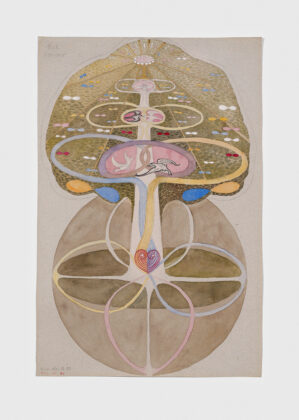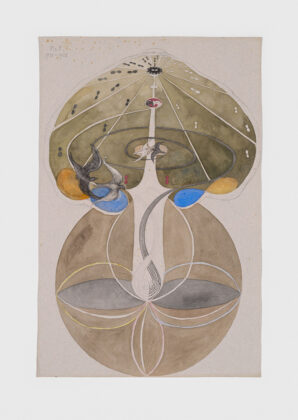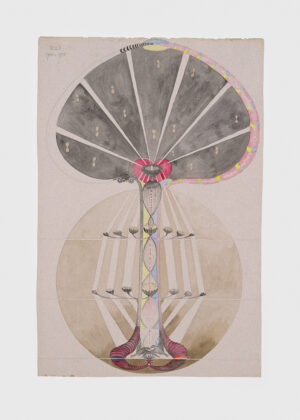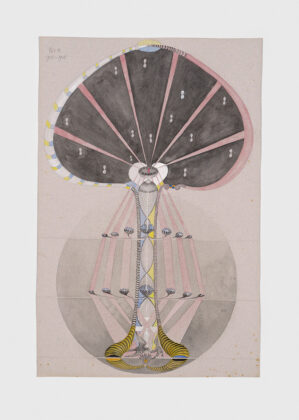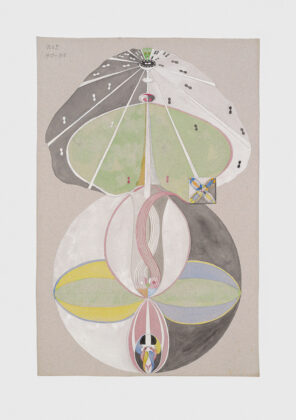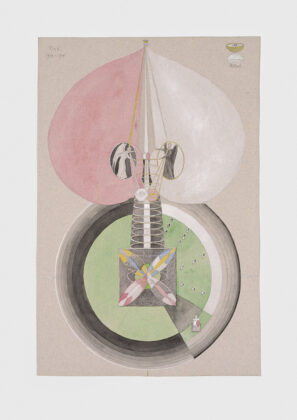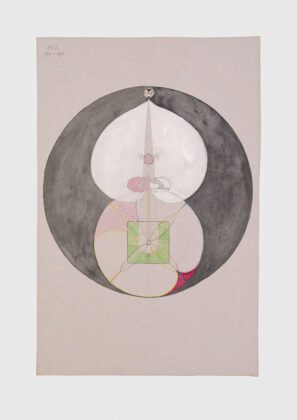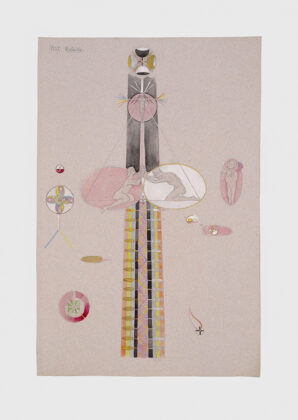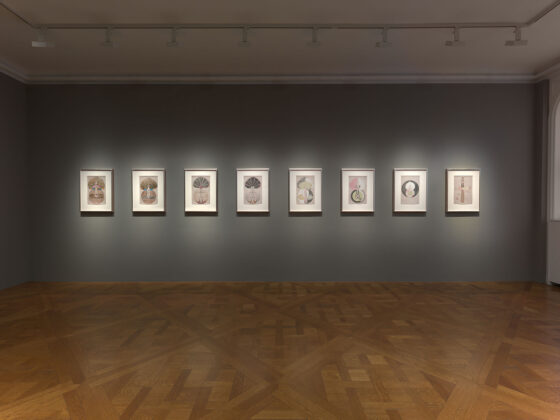Swedish painter Hilma af Klint (1862-1944) is enjoying a major reappraisal as the very first artist to paint abstraction. Her first nonobjective effort was made in 1906, five years before Kandinsky began working abstractly. In October 2018, the Guggenheim Museum put on a major retrospective of the artist, who stipulated that none of her work was to be shown publicly until twenty years after her death. Technically skilled, mystically minded, and prescient in major ways, af Klint had little interest in a public career. Instead, she followed her own path, embracing the occult and supernatural—she regularly held séances with artist friends—and generally developed a schematic, nonobjective style. This show of her “Tree of Knowledge,” a series of eight watercolors done between 1913 and 1915, recently found in Switzerland (this is one of two versions), presents a sequence devoted to an abstract, yet recognizable treatment of the Biblical tree, whose forbidden apple possessed the knowledge of good and evil. Af Klint, given to a personal mysticism that she described regularly in abstract terms in her paintings, found in the Biblical narrative a great symbol she could refer to, even if her handling of the image is extensively abstract. It is clear that the series’ iimplications, devotional, moral, and visionary, would be understood at once by a Western audience.
The artist’s work is often filled with rounded, organic imagery that refers only to itself. Color plays an important role in af Klint’s treatment of circles and spheres, of different sizes and often jostling each other in her paintings. Inspired by an otherworldly thinking that might seem dated to a contemporary audience, Klint made work that was ahead of its time in its abandonment of realism. Instead, she favored an imagery resolute in its non-objectivity. As the first artist to work this way, she was quite aware of her isolated position—she lived a quiet life and looked to the future, beyond her death, for recognition. It is only now, close to eighty years after she passed away, that Klint is receiving the recognition she deserves. To a current viewer, the art may seem slightly overdetermined and fin de siecle, its floral leanings transformed into original patterns that nonetheless feel dated. The imagery is often ornamental and can, at times, seem arbitrary. The designs, then, may look artificially constructed rather than wholly innovative. But we must remember the courage and visual daring of someone making this work—we must remember she was born in the middle of the 19th century, whose art gave no hint of the abstraction to come. While she lived into the middle of the 20th century, which would have allowed her to experience many kinds of abstraction, af Klint can be seen as a transitional figure, someone who ushered in a genuinely new vision spanning the cusp of two centuries.
Additionally, any descriptive writing on af Klint must include the symbolic tenor of her art, knowing as we do her penchant for the supernatural. Her treatment of unseen forces, recognized by intuition and rituals lacking ties to conventional religion, is convincing but difficult to specify and analyze. Af Klint’s organicism derives from her belief that the spirit life exists around us and indeed can be contacted if we use the right means. Her work is highly inventive and successful in its presentation of the transcendent. At the same time, it begs the question, How can spiritual experience, invisible from the start, be shown in a manner adequate to its utopian force? In certain kinds of art and writing, the artist and author are determined to find ways of spiritual expression. To do so in fully abstract terms is to evolve a vocabulary that stands outside the conventional recognition of things. New symbols must be devised; a new language must come into being. So af Klint’s prescience reminds us that the experience of new art depends on its difference from what preceded it. By developing a language not in common with representation, af Klint originated a visionary outlook that left the late 19th century for the 20th century. Her work, had it been seen widely and understood for its inventiveness at the time it was made, would have received the acclaim she is only meeting with now.
Thus, af Klint’s experimentation would have to wait until the early part of the 21st century to become well-known. This is, of course, based in part on her decision to delay showing her paintings until 20 years after her death. But the gap between her work and its cognizance is greater than that, resulting perhaps from her distance from Western Europe, where many art advances occurred, as well as the fact of her gender. As a woman, it is likely she would have been consigned to the margins during the duration of her creativity, especially as an originator of something entirely new. Her female identity would easily separate her from the mostly male practitioners of early modernism. It is important, then, that we give credit to her daring and independence in finding an idiom that moved into non-representational spaces. If Klint’s language can seem ornamental at times, it is also clear that her imagery offers us the chance to appreciate form on its own terms, without reference to identifiable objects. Abstraction demands that its audience appreciate the inherent beauty of forms that stand alone, free of demonstrable ties to realism. In af Klint’s case, this freedom provided the artist with a window onto the unknown, a spiritual life closer to the occult than to conventional devotion. Today, with more than a century of abstract work to consider, non-objective painting is finding it hard to offer a new style. As the first artist to develop abstraction, af Klint did not face this problem. Instead, she explored unknown ground, favoring the unrecognizable over the easily understood.
Visually, the eight watercolors are closely related. In Tree of Knowledge, No. 1 (all the works were completed between 1913 and 1915), we see the crown of the tree, painted brown, occupy the upper half of the composition. Three circular lines, partially attached to the tree trunk extending fully upward, embellish the crown, each one growing smaller as the tree rises. Inside the circles are ovular lines containing doves, the only non-abstract image available. Small connected oval shapes of different colors punctuate the lower half of the canopy, while a circle stands at its top. The lower half of the tree consists of a circle penetrated by the tree trunk, with thin roots drawn out from it. Ovals within the circle give this part of the artwork a slightly floral, decorative flair. Symmetry abounds in the image, intensifying our sense that af Klint’s abstraction, like much abstraction, may be slightly dependent on things seen in life. Yet the overall impression moves from design into a non-objective site, whose elements are distilled very much from the imagination.
In the No. 2 watercolor, the overall gestalt of the image is very similar: a mushroom-shaped canopy at the top; and a circle filling the lower half. Both parts are colored brown. A spiral line encircles the trunk as it narrows while moving higher, toward the top of the work; at the top is a small, horizontal oval from which straight white lines radiate. Beneath, within the circular boundaries, we find that the light-colored trunk has become thick. Ovals, using the bottom of the tree, move outward toward the edges of the circle. Unlike some of the other works by af Klint, which are more fully abstract, this series occupies a middle ground between schematic design, based on the image of the tree, and full-fledged abstraction. In No. 4 of the sequence, once again the general shape of the watercolor is closely similar to the ones discussed. But this time the top half is a dark brown, with pinkish stripes emanating from an eye-like image set between the two halves of the work. The circular bottom half is occupied by a tree trunk consisting of decorative patterns: tear shapes whose interiors contain white dots, with pinkish, jointed stripes filling the sphere on either side of the tree. The edges of the trunk are defined by a narrow tube with black-and-white stripes circling them; as the two tubes descend, they grow wider, encircled by yellow and black stripes.
In af Klint’s work, an important question needs to be asked, one that we still face today. There is something embroidered about the imagery: Can decoration be considered more than surface treatment in art? My sense is that af Klint remarkably transformed the ornamental into abstraction, in a way that joined her experience of decorative art before she began working in abstraction. Doing so enabled her to take the non-objective elements of ornament and isolate them into elements that did not link up in any real way with what we see. Thus, the imagination gained strength—over the realities of the eye. It certainly makes sense that af Klint would use ornamentation in her abstract work; in the later part of the 19th century, decoration was a major element of art; one has only to think of the French artists working in the art nouveau manner, much in popularity around the turn of the century. It feels like af Klint took this style and expanded its innate decorative tendencies into a language that correlated with nothing but itself. As a result, she produced the first efforts of non-objective painting.
But it must be said that af Klint’s “Tree of Knowledge” sequence is also organized around something recognizable and historically established. This would mean that not only is the imagery complex in its embrace of both abstraction and figuration, it is also a set of pictures stemming from the artist’s very strong interest in metaphysics. The title would immediately be understood as a Biblical reference, then and now. Yet af Klint’s penchant for the image as a neutral component—something that would complete its meaning without external reference—is evident in this outstanding group of works. In No. 5, the canopy at the top is half dark gray on the left and half white on the right, while white stripes stream away from a small black oval at the tip. Pairs of small dots, white on the left and black on the right, randomly cover the top of the tree, whose interior is painted a light green. At the bottom of the tree, the trunk has been replaced by two of four oval forms, variously colored within. The two vertical ovals are filled with differently undulating, differently patterned stripes. All four ovals occur against a double background: white on the left half and dark gray or black on the right. Here an abstract layout mostly takes over any sense of a discernible tree, even though the basic forms are maintained. Organic patterns dominate our experience of this example in the series.
As a sequence, “The Tree of Knowledge” reiterates what we have come to understand about af Klint. She is an artist of notable originality, as well as a painter of invisible energies. This is accomplished by a merger between an end-of-the-century style and a new visual vocabulary. Who would have thought, in 1906, that af Klint’s breakthrough would start an unprecedented movement emphasizing form in isolation? Additionally, who would have thought that it would take so long for the worldwide art community to recognize her contributions? Clearly, she deserves a place in the canon; she was more than a little ahead of her time—a position she herself noted by delaying the exhibition of her art until after her passing. Now, in a time, when art historians are revising cultural history to include the still underrecognized efforts of women, it is deeply important that af Klint is seen for the exceptional innovator she is. Recognizing her gifts will amplify and enrich the contribution of women to fine art; they have alway been part of art history, even though their accomplishments have not been fully considered.
Texto en español



